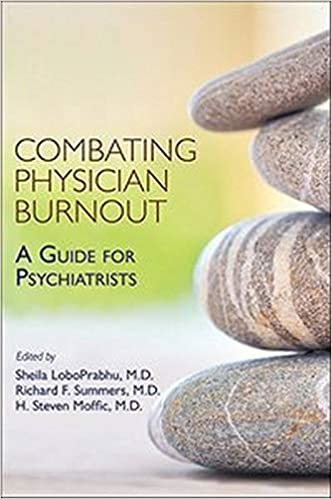Combating Physician Burnout
Full Title: Combating Physican Burnout: A Guide for Psychiatrists
Author / Editor: Sheila LoboPrabhu, Richard F. Summers, and H. Steven Moffic (Editors)
Publisher: American Psychiatric Association Publishing, 2019
Review © Metapsychology Vol. 25, No. 12
Reviewer: Sharon Packer, MD
When this book first appeared, in early 2020, just before news of the COVID epidemic emerged, this book about physician burnout seemed so timely. I never imagined that it could become even timelier, yet that has happened, yet again.
In the midst of the pandemic, physician burnout skyrocketed again, and is at an all-time high; up to 70% of psychiatrists report burnout. Ironically, this book is directed toward psychiatrists who treat other physicians of all specialties, psychiatrists included. Apart from a few select specialties, most practicing doctors report even higher rates of burnout than psychiatrists.
This book of 15 chapters includes three separate chapters on the challenges of treating psychiatrists themselves, and on preventing burnout in psychiatrists, who are encharged with treating other physicians and consequently may merit extra attention in this handbook. All other chapters address more global issues that pertain to doctors in general and include both clinical and ethical considerations. One chapter focuses on medical students and residents.
Rather than reflexively “blaming the victim,” the editors include detailed lists of external factors that contribute to burn-out, which range from economic to social and socio-political to technological (EMRs) to familial to institutional. Issues pertaining to gender are included within other chapters, with special emphasis on work-family conflicts. Personal clinical concerns, such as preexisting psychiatric problems, or substance use, are not dismissed but are discussed at length. Had this book been published in 2021, I suspect that an extra chapter on minority and race-related issues might have been added, and that such a chapter might have illuminated more reasons for the underrepresentation of persons of color in the medical profession.
The editors differentiate “burn-out” from depression, and further differentiate clinical depression from completed suicide, warning us that there are often no warning signs whatsoever of impending suicide by physicians. Instead of addressing substance-related issues in a separate chapter, the authors weave these important issues into a chapter on impairment and provide a wealth of details about the specifics of substance abuse, and how it compares to or contrasts with parallel concerns in the general population. By citing impressive statistics, it debunks many myths surrounding physician substance use and suicide, yet it never loses sight of the significance of all of these issues, whenever or wherever they occur.
In recent months, prestigious medical journals such as New England Journal of Medicine have challenged the stigma surrounding reporting of physician illness or impairment and have recapitulated stances previously published in psychiatric journals. This book reifies those more enlightened attitudes and suggests ways to prevent such concerns from surfacing in the first place. Rather than pointing fingers or placing blame on institutionalized medicine, or on specific medical boards, for their sometimes-punitive approaches toward physician health, this book posits solutions for the future instead of focusing exclusively on problems in the present.
In summary, this book is ostensibly directed towards psychiatrists in particular who are engaged in the treatment of physician colleagues, or of other psychiatrists, or of physicians-to-be. It is not presented as a self-help book for other physicians. Yet I predict that many physicians from other specialties will read this book, and find the detailed data to be helpful, and encouraging enough to motivate them to seek psychiatric treatment as needed, before they themselves become part of the statistics cited in the text. In that way, this book is helpful to all readers, and to society in general, which will benefit from better physician health.
In spite of its ample and assiduous documentation and citations to studies, this book is an easy read for all physicians and their families. I predict that it will interest mental health professionals in general. This book is a must-read for residency program directors, for medical school deans of student affairs and for the many physicians who devote themselves to the emerging subspeciality of “physician health.”
Sharon Packer, MD is a psychiatrist who is in private practice in Soho (NYC) and Woodstock, NY. She is an Asst. Clinical Professor of Psychiatry and Behavioral Sciences at Albert Einstein College of Medicine. Her books includeDreams in Myth, Medicine and Movies (Praeger, 2002), Movies and the Modern Psyche (Praeger, 2007) and Superheroes and Superegos: The Minds behind the Masks (Praeger/ABC-Clio, 2010). In press or in production are Sinister Psychiatrists in Cinema (McFarland, 2012) and Evil in American Pop Culture (ABC-Clio, 2013, co-edited with J. Pennington, PhD.) She can be contacted at drpacker@hotmail.com .
Categories: General
Keywords: physician burnout

